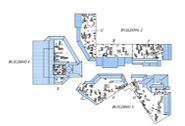Frequently asked roofing questions
What is the difference between built-up roofing and single ply roofing?
Built-up roofing refers to any roofing system that is installed in multiple layers, using asphalt as the primary waterproofing component. The built-up system may use traditional roofing felts or modified bitumen felts.
Single ply roofing indicates a system comprised of a single membrane, which can be a variety of types of formulations. The most common systems are PVC (polyvinyl chloride), TPO (thermoplastic polyolefin), or EPDM (ethylene propylene diene monomer). These systems may be mechanically attached, adhered, or ballasted.
What is a roof maintenance coating system?
This is a coating system applied over an existing roof membrane and designed to extend the service life of the roof. The coating system is comprised of multiple applications of a fluid applied coating, reinforced with fabric or webbing that is embedded into the coating application. Most commonly, maintenance coating systems are comprised of emulsion, reinforcing fabric, and a white acrylic coating. Other maintenance coating systems may employ chopped fiberglass reinforcing or an aluminum coating.
What is surfacing?
Surfacing is the element of the roof membrane system that provides protection from ultraviolet exposure. Surfacing may be granules, gravel, or an ultraviolet resistant coating.
What odors are associated with roofing?
With a traditional built-up or modified bitumen roof system, there is the smell of asphalt. Although not toxic, the smell can be annoying or may cause minor headaches or nausea to people sensitive to odors. Generally, when a built-up roof membrane is being installed on an occupied building, the installer will shut down and cover air intake systems on the roof when working in close proximity to those units. This will reduce the smell entering the building.
With single ply membrane or coating system installations, there may only be minor odors associated with adhesives, primers, or cleaners.
My building is being re-roofed. What noise can I expect?
Depending upon the scope of the project, the noise with vary. If a removal of the existing system is undertaken, there will be noise associated with the extra personnel on the roof as well as scraping and pounding. Often, roof removal is conducted during off-hours so as to create the least amount of disruption to tenants.
Roofing installation noise will depend upon the system being installed. With built-up roofing there will be the noise of nailing, generally for the first 3 or 4 hours of the day, followed by the noise of foot traffic. With a mechanically attached single ply system or when insulation is being installed, there will be the noise from screw guns throughout the day.
What are flashings?
Flashings refer to any accessory items on the roof that provide a specific waterproofing element secondary to the roof membrane itself. This includes base flashings at horizontal to vertical transitions and sheet metal components used to address penetrations made through the roofing or waterproofing system.
What are Modified Bitumen systems?
Modified bitumen refers to a traditional asphalt based product that has been modified with either SBS (styrene butadiene styrene) or APP (atactic polypropylene). The modifiers are added to provide more flexibility and enhance the properties of traditional built-up roofing materials. Modified bitumen products include roofing interply felts, surfacing sheets (cap sheet) and adhesives.
What is “cool roofing?”
Cool roofing refers to roofing systems that meet or exceed Energy Star requirements for reflectivity and emissivity. The established properties are designed to reduce the “heat island” effect caused by traditional roofing systems. In other words, “cool roofs” retain much less heat than traditional roofs.
In California, Title 24 establishes minimum reflectance and emissivity values for roofing that exceed Energy Star cool roof standards.
Need help understanding some of these terms? here is a link to the NRCA Glossary


